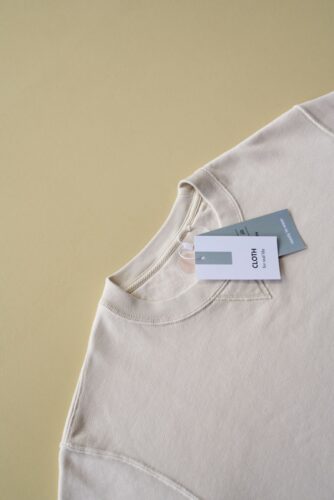Autism Clothing for Sensitive Skin Can Enhance Quality of Life
For those with autism spectrum disorder (ASD), getting dressed in the morning can sometimes be an overwhelming experience. Many people on the spectrum have sensory sensitivities that make certain textures, fabrics, and clothing styles unbearable to wear.
 Autism clothing sensitivities such as tags, seams, and rough fabrics can cause irritation or tactile overload. Tight, constricting garments may trigger feelings of panic and anxiety.
Autism clothing sensitivities such as tags, seams, and rough fabrics can cause irritation or tactile overload. Tight, constricting garments may trigger feelings of panic and anxiety.
With so many potential sources of discomfort, finding autism clothing that doesn’t provoke sensory issues is crucial for making day-to-day life manageable. By being selective about fabrics, fits, and features, people with autism can build a wardrobe of clothing for sensitive skin that minimize feelings of stress and anxiety.
Here are some top tips for finding autism clothing that is comfortable, soft, and sensory-friendly.
Choosing Autism Clothing For Sensitive Skin
Typically, favored autism clothing comes from ones made with natural fabrics. Natural fibers like cotton, wool, silk, and linen tend to be the most comfortable and breathable fabric choices.
The softness and airflow of these materials make them ideal as clothing for sensitive skin for those with tactile sensitivities. This type of autism clothing conforms to the body without constricting. Natural fabrics also tend to last longer and show wear less than synthetic blends.
Fabric Guidelines for Supporting Autism Clothing
Look for these specific fabrics.
- Aim for lightweight cotton with some stretch for T-shirts, underwear, dresses, and other garments that touch the skin directly. Pima cotton and supima cotton have extra-long fibers for ultra softness. Linen and cotton blends can also feel nice, though linen wrinkles easily.
- Merino wool is a good choice for sweaters, dresses, and other colder weather gear. It has natural moisture wicking properties to avoid feeling damp against the skin. For those in very warm climates, lightweight tropical wool could be a good option for autism clothing.
Be careful when choosing wool, however, in that some are scratchy and don’t work well with clothing for sensitive skin. Another consideration is to read the label before purchasing and see how the garment must be cleaned.
- Look for silk in pajamas, lightweight blouses or shirts, underlayers, and dresses. It feels luxuriously soft and won’t provoke irritation. Silk is also temperature regulating.
It can require extra care in cleaning, so when possible, look for silk that can be washed vs. dry clean only, as the chemicals in dry cleaning can also be a problem with autism clothing.
- Cashmere sweaters and other accessories may feel soothingly soft for autism clothing for some people on the spectrum. But the expensive price tag makes it hard to stock up and care can be complex for some. Reserve cashmere for one or two special transitional weather pieces.
In general, steer clear of man-made fabrics like polyester, nylon, acrylic, and rayon if possible. While athletic wear is often made of synthetic technical fabrics, try to find natural fiber options for daily wear. The softness simply can’t be matched for clothing for sensitive skin.
Autism Clothing: Seek Out Seamless Styles
Rough interior seams on clothing can scratch and irritate delicate skin. Searching for pieces that are seamless or have flat seams on the inside helps avoid this issue. For undershirts, underwear, and layering pieces closest to the body, seamless is ideal.
Seamless garments are knit with circular machines so that there are no side seams. There are numerous brands that specialize in affordable seamless underwear and layering shirts. High end brands also make seamless merino wool undershirts for cold weather.
In addition, a number of makers sell workout clothes with seamless engineering. In addition, check sites for medical grade seamless compression garments to wear under daily clothes as an option for autism clothing for sensitive skin.
Also consider autism clothing that is tag-free. More and more brands are touting tag-free clothing for sensitive skin, because it is seems to be preference of a majority of individuals.
For outer pieces, look for flatlock stitching on the seams. Flatlock stitching folds the edges of the fabric in before stitching for a smoother seam. It helps nix irritation from contact with protruding seams. Some brands utilize flatlock stitching in some durable workwear options as a protective measure.
In general, curved seams that don’t have corners or edges also create less friction as an option for autism clothing. Opt for rounded necklines when possible. And definitely avoid heavily embellished garments that have beading, sequins, or applique details that add texture and are typical no-no’s as clothing for sensitive skin.
Choose Loose, Flowy Silhouettes as Autism Clothing Options

Drawstring waists provide comfort and flexibility. Also, wide leg pants and long, full skirts don’t cling or constrict circulation for autism clothing options.
When shopping, look for breathable jersey, silk, or cotton, loose fitting sleeves and cardigans and outerwear that layer without bulk.
In addition, consider pants in lightweight cotton/hemp/linen blends and seek autism clothing that isn’t too structured or restrictive and provides the ability to move freely without tactile overload.
Avoid styles like “skinny jeans” and instead opt for a looser cut that is easier to pull on and take off. Zippers can sometimes bother individuals, but luckily there are pull on or tie-styles that are in fashion right now as well.
Autism Clothing Adaptive Styles for Sensory Needs
Many mainstream clothing brands don’t factor sensory issues into their designs. But there are some companies producing functional, comfortable styles specifically for the autism community. Checking sites for autism clothing and for other special needs will turn up clothes adapted for sensitivities like:
- Flat seams, circular knitting, and seamless construction
- Tagless or tear-away tags to eliminate scratching
- Extra soft natural fabrics like cotton jersey and modal
- Integrated compression for soothing pressure
- Discreet openings for mobility aids
- Diaper-friendly functionality for older children and adults
- Weighted pieces to provide calming pressure
- Adaptive closures like pull-on pants, magnetic buttons, and hook & loop closures for ease
The selection includes everything from innerwear to outerwear for all seasons and age groups. Be ready to pay more for the adaptive features. But the autism clothing designs allow people to get fully dressed and go about daily activities without restrictive discomfort.
Autism Clothing: Wash Purchases Before Wearing
Brand new clothes often feel extra scratchy and irritating against the skin. The fabrics may be a little stiff or rough until they are broken in. Washing new garments a few times on a gentle cycle helps soften them up immensely.
So don’t throw on that new pair of jeans or linen shirt fresh out of the package. Make sure to prep them with a few warm water loads tumbled dry low to help break in clothing for sensitive skin issues. Try washing with an extra rinse or all-natural fabric softener to improve feel too.
Just be sure to avoid heavily fragranced products, as the perfumes can also cause sensory overload issues for those on the autism spectrum.
The same goes for scratchy socks, stiff underwear, and rough sheets on a new bed. Take some time to wash and re-wash until they reach maximum softness. This simple laundry step goes a long way in preventing skin irritation and discomfort throughout the day.
Listen to Your Body About Clothing for Sensitive Skin
At the end of the day, the most important autism clothing guideline is listening to your own sensory thresholds. Every person with ASD has unique sensitivities across the various senses. If certain fabrics, sleeves, or pant lengths cause you tactile distress, avoid them at all costs. Don’t suffer through overwhelming discomfort just to fit some arbitrary dress code.
Instead, stick to the specific items in your closet that you already know feel soft and comfortable against your skin. It’s fine to default to those trusty pieces day after day until you methodically find more options.
By respecting your own sensory limits, you can incrementally create a safe autism clothing wardrobe that minimizes feelings of stress and anxiety about getting dressed.
Tailor Clothes for the Perfect Fit Can Help with Some Autism Clothing Concerns
Off-the-rack clothing is made to fit a generic body shape, which may not suit your proportions. Getting pieces tailored can improve both the fit and the feel of garments. A skilled tailor can:
- Take in, let out, or adjust waistbands and side seams so pants and skirts don’t pinch or gap.
- Hem pants and sleeves to the ideal length that doesn’t constrict movement or feel too long.
- Remove bulky lining or padding to streamline the silhouette.
- Replace buttons or zippers with softer fasteners like Velcro closures.
- Remove distracting embellishments like sequins or beads.
- Reinforce seams to make them flatter and less irritating.
- Add expansion panels to sides or backs of pants and tops to make getting in and out easier.
For people with atypical body proportions, getting a made-to-measure custom piece may be the best option for fit. A few measurements will get perfectly contoured pieces suited to your shape.
It’s a pricier option but eliminates the stress of shopping to find the desired garment that fits just right off the rack.
Be Picky About Undergarments for Choosing Autism Clothing
For extended comfort when choosing clothing for sensitive skin, focus extra attention on choosing soft, non-irritating underlayers next to the skin. Look for:
- Seamless underwear in breathable fabrics like bamboo or modal.
- Wireless bras in ultra-soft cotton, or bralettes made of stretch lace or ribbed cotton for light support and comfort. Opt for wide bands not tight elastic.
- Low profile camisoles or undershirts in luxurious silk or merino wool to create a soothing base layer.
- Seamless low-cut socks, compression socks, or cotton crew socks with minimal seaming. Some shoppers even wear socks inside out to hide seams.
- Well-fitting undergarments that neither cut in nor shift around throughout the day causing distraction. Proper fit eliminates the need for scratchy elastic or bands digging into skin.
By dressing with autism clothing in mind, you can create a literal foundation of softness that makes getting dressed peaceful. Spend time finding pieces that feel great against your skin before building up the outer layers of an outfit to create acceptable autism clothing that works for you.
We all deserve to feel cozy and content in our own clothes. By being selective about fabric, fit, seaming, and function, people on the autism spectrum can curate a personal collection of garments ideally suited to their sensory needs.
Focus on natural fibers, comfort cuts, and adaptive styles while respecting your own boundaries. With time, you will build up a closet full of go-to pieces of clothing for sensitive skin that allow you to dress comfortably as you go about your daily life.
My Personal Take on Autism Clothing for Sensitive Skin

Good clothes that work with clothing for sensitive skin promote positive self-esteem and promote your mental health.
Comfortable and beautiful clothes can make you feel confident and help you live your best life, but on the other hand, uncomfortable autism clothing can make feel bad about yourself and get in the way of living your best life.
This is why good clothes that work for you and any tactile requirements are important. An autism clothing wardrobe that is right for you affects your mind, how you feel about yourself, and about life. So don’t underestimate the power and value of good clothes because they can really change your life.
After all, your unique sensory system deserves to feel peaceful and content as you go about your daily life.
An additional consideration for me when finding autism clothing that is comfortable is that I do my own laundry. Because of it, I pay extra special attention to the clothes I buy because they need to feel soft and not scratchy, wash well, and to be made with good quality that are durable through frequent washings.
It is very important that my clothes are comfortable, because when they aren’t my body can actually break out in hives from certain fabrics, and because uncomfortable clothing can ruin my entire day.
Individuals with autism like me have enough challenges in life, and wearing clothes that look and feel good shouldn’t be one of them.
Autism in Adults: Living, Learning, and Overcoming Challenges for a Fulfilled Life
Autism in adults requires additional support and coping skills to achieve independence in today’s world. Learn more about ways adults can live fulfilled lives and the challenges they face.
- 14 Practical Ways for Staying Motivated to Unlock Full Potential
- Dangers of Social Media Addiction: How To Leave the Screens And Face the Real World
- Autism Volunteer Opportunities: 5 Ways Helping Others Fosters Acceptance
- 8 Heartfelt Ways Autism Emotional Support Animals Transform Lives
- Autism in the Future: Optimism for Improved Perception and Embracement
- Autism and AI: 7 Discoveries About the Surprise Pairing and Profound Impact
- Are You An Adult With Autism? Here Are 6 Signs
- Autism After High School: Is College the Next Step?
- Autism vs Asperger’s Syndrome: What You Need to Know
- Autism Disclosure: Is Revealing Your Disorder Helpful or Hurtful?
- Work and Autism: What Employers Should Know About Hiring People Like Me
- Drivers with Autism Can Achieve Success Behind the Wheel